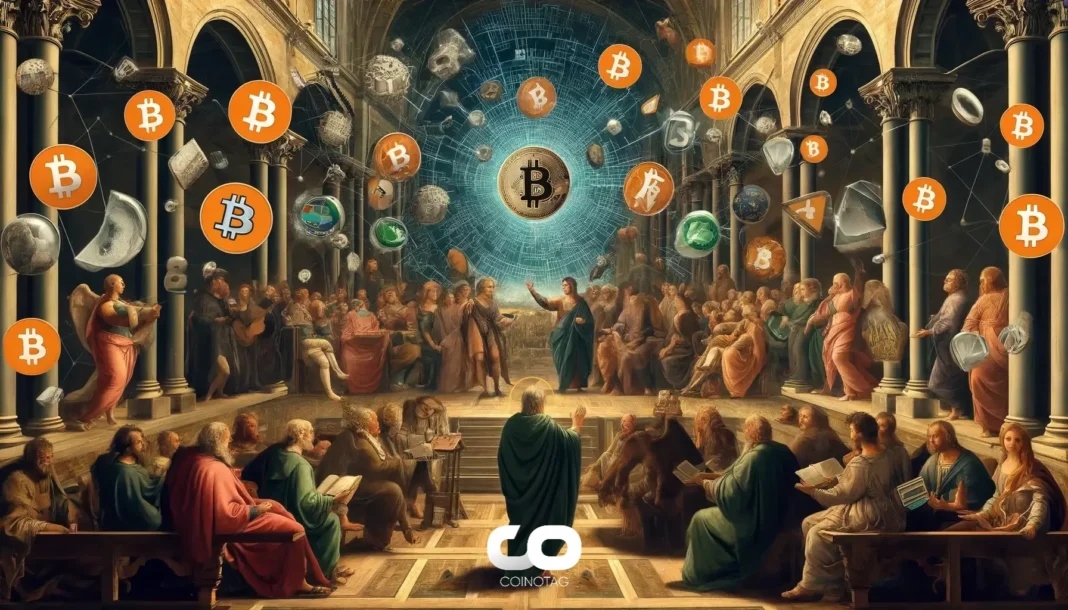- The Jekyll Island Club, once a retreat for America’s wealthiest individuals, was the setting for an unusual spectacle this Wednesday morning.
- An inflatable rat, standing seven feet tall and marked with code attributed to Bitcoin’s pseudonymous creator Satoshi Nakamoto, was seen on a balcony of the Sans Souci Cottage, a building associated with J.P. Morgan.
- The inflatable rat was erected by Nelson Saiers, a mathematical artist known for incorporating crypto themes into his work.
This article delves into an extraordinary event at the historic Jekyll Island Club, exploring the motives behind a creative protest led by Nelson Saiers that captures the tension between traditional banking and modern cryptocurrency.
An Unexpected Sight at a Historic Venue
On Wednesday morning, visitors to the Jekyll Island Club, a site steeped in American financial history, were greeted with an unusual sight. A towering, seven-foot-tall inflatable rat adorned with the distinctive markings of Satoshi Nakamoto’s Bitcoin code loomed over Sans Souci Cottage, unsettling the historic tranquility of the site. This cottage, partially owned by the legendary financier J.P. Morgan, was suddenly juxtaposed with the modern world’s digital dissent.
Nelson Saiers: Fusing Art and Finance
Nelson Saiers, a former derivatives trader and hedge fund manager turned mathematical artist, is the mastermind behind this audacious display. Known as the “Warhol of Wall Street,” Saiers has a history of using his art to comment on the financial system. In 2018, he staged a similar event outside the New York Federal Reserve. By placing this rat at the Jekyll Island Club—often referred to as the birthplace of the Federal Reserve—Saiers continues to make bold statements about financial inequities and the power structures within banking.
The Federal Reserve’s Controversial Genesis
The Jekyll Island Club is not just any location; it’s a cornerstone of American banking history. Over a century ago, it hosted secretive meetings of powerful American bankers who drafted the foundational legislation for what would become the Federal Reserve, following the financial tumult of the Panic of 1907. This backdrop adds layers of meaning to Saiers’ artistic protest, highlighting the longstanding entanglement of elite financial interests and federal banking policies.
Messages Embedded in Art
Saiers’ inflatable rat bears more than just Nakamoto’s code; it features the acronym “POW” within one of its eyes. This stands for “proof-of-work,” the consensus mechanism integral to Bitcoin’s operation. It’s also a nod to the renowned artist Roy Lichtenstein, adding a dual layer of cultural and technical reference. This mixing of symbols underscores the tension between the established norms represented by the Federal Reserve and the disruptive potential of cryptocurrency.
Historical Context and Modern Resonance
Interestingly, Saiers’ latest public installation coincided with significant milestones in the history of U.S. central banking. The rat’s appearance came precisely 111 years after the House of Representatives passed the Federal Reserve Act, signaling the creation of America’s central banking system. This historical synchronicity enriches the narrative thread of Saiers’ critique, suggesting that the themes of financial elitism and systemic critique are as relevant today as they were over a century ago.
Public Perception and Financial Systems
In a recent interview, Saiers expressed that many people feel a palpable sense of unease about the fairness of the financial systems. He believes that the clandestine origins of the Federal Reserve contribute to public distrust. Furthermore, Bitcoin, despite its challenges and controversies, symbolizes resilience and an alternative to an elitist financial order. Saiers’ art provocatively suggests that while traditional financial institutions appear to benefit an elite few, digital currencies offer hope for a more equitable system.
Art as Commentary on Modern Finance
The inflatable rat also indirectly references Warren Buffett’s famous description of Bitcoin as “rat poison squared.” Saiers flips this pejorative on its head, suggesting that the experimentation and unorthodoxy seen during the 2008 financial crisis, likened to lab experiments on rats, have carried over into today’s fintech innovations. His artwork serves as a reflection on this ongoing financial experimentation, challenging viewers to reconsider the power dynamics at play.
Conclusion
Nelson Saiers’ installation at the Jekyll Island Club poignantly marries art and historic critique. By situating his work in such a charged context, he draws attention to lingering issues within the financial system and posits Bitcoin as a resilient alternative. Readers are left to ponder the enduring implications of these financial power dynamics, both historical and contemporary, and consider the evolving role of cryptocurrency within our global economic landscape.







